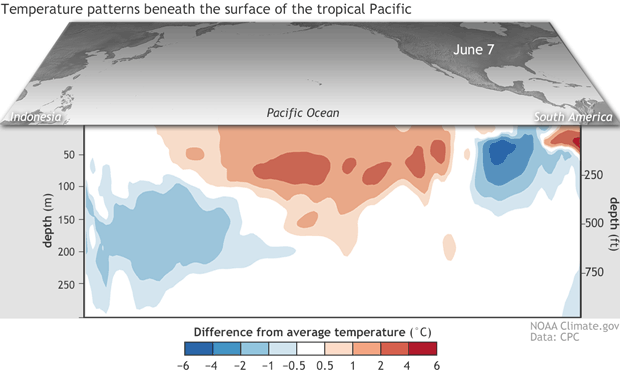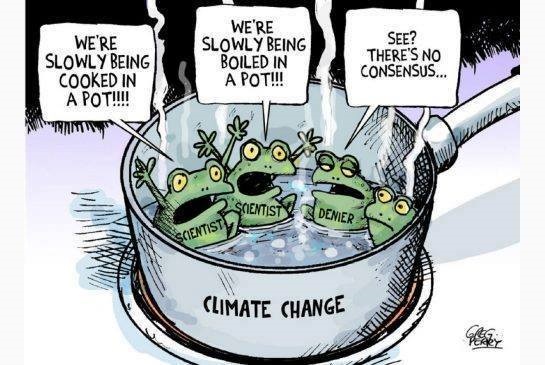2019 SkS Weekly Climate Change & Global Warming Digest #28
Posted on 14 July 2019 by John Hartz
Debunk of the Week... El Niño/La Niña Update... Toon of the Week... Coming Soon on SkS... Poster of the Week... SkS Week in Review...
Debunk of the Week...
Non-peer-reviewed manuscript falsely claims natural cloud changes can explain global warming
CLAIM: "Man-made Climate Change Doesn't Exist In Practice... During the last hundred years the temperature is increased [sic] about 0.1°C because of carbon dioxide. The human contribution was about 0.01°C."
Some news outlets are publishing articles stating that this claim is based on a new study. In reality, there is no new published study. The claim comes from a six-page document uploaded to arXiv, a website traditionally used by scientists to make manuscripts available before publication. This means that this article has not been peer-reviewed, so there is no guarantee to its credibility.
If the blogs that covered this as a new study had contacted independent scientists for insight, instead of accepting this short document as revolutionary science, they would have found that it does not have any scientific credibility.
As the scientists who examined this claim explained, the document relies on circular reasoning to claim that cloud cover and relative humidity have caused the change in global temperature, and ignores many additional factors affecting global temperature—including aerosol pollution, volcanic eruptions, and natural ocean oscillations. The published, peer-reviewed scientific research on this topic clearly shows that human activities are responsible for climate change.
Non-peer-reviewed manuscript falsely claims natural cloud changes can explain global warming, Claims Review Edited by Scott Johnson, Climate Feedback, July 12, 2019
El Niño/La Niña Update...
July 2019 El Niño update: I think I’ll go for a walk
El Niño is hanging on by its fingernails, but forecasters predict this event will wind down within the next couple of months. It’s likely that the temperature of the tropical Pacific Ocean surface will return to near-average soon, qualifying for “ENSO-neutral” conditions. Neutral conditions are favored to remain through the fall and winter.
Not dead yet
The June Niño3.4 index, our primary ENSO measurement, was 0.6°C above the long-term average, just above the El Niño threshold of 0.5°C. There is some evidence that the atmosphere over the central Pacific is still responding to that extra heating, as a bit more clouds and rain than average were present in June.
The Southern Oscillation Index and Equatorial Southern Oscillation Index were both slightly negative in June, also indicating some continuation of the weakened Walker circulation we expect to see with El Niño. But the upper-level and near-surface winds over the equatorial Pacific, another component of the Walker circulation, were close to average during June. All in all, El Niño is still present, but just barely.
That’s no ordinary rabbit
As frequent readers of this blog will know, we closely monitor the temperature of the water under the surface of the tropical Pacific. This can tell us if there is a source of warmer-than-average water to supply the surface, continuing to fuel El Niño, or not. In early June, there was a small downwelling Kelvin wave of warmer waters moving eastward under the surface of the Pacific, but this wave has dissipated recently.

Departure from average of the surface and subsurface tropical Pacific sea temperature averaged over 5-day periods starting in early June 2019. The vertical axis is depth below the surface (meters) and the horizontal axis is longitude, from the western to eastern tropical Pacific. This cross-section is right along the equator. Climate.gov figure from CPC data.
Overall, the heat content in the top 300 meters of the equatorial Pacific is just about average now, in early July. This is one of the major factors in our forecast for a return to near-average surface temperatures and neutral ENSO conditions. Once the surface temperatures return to average, and the source of extra heat to the air above the central Pacific is gone, the atmospheric component of El Niño—that weakened Walker circulation—will also return to average.
July 2019 El Niño update: I think I’ll go for a walk by Emily Becker, NOAA's Climate.gov, July 11, 2019
Toon of the Week...

Coming Soon on SkS...
- 10 things a committed U.S. President and Congress could do about climate change (Craig Chandler)
- New Research Reloaded (Doug Bostrom)
- What psychotherapy can do for the climate and biodiversity crises (Caroline Hickman)
- How climate change is making hurricanes more dangerous (Jeff Berardelli)
- 2019 SkS Weekly Climate Change & Global Warming News Roundup #29 (John Hartz)
- 2019 SkS Weekly Climate Change & Global Warming Weekly Digest #29 (John Hartz)
Poster of the Week...

SkS Week in Review...
- 2019 SkS Weekly Climate Change & Global Warming News Roundup #28 by John Hartz
- Disappearing sea ice is changing the whole ecosystem of the Arctic Ocean by Graham J. C. Underwood (The Conversation UK)
- Skeptical Science New Research for Week #27, 2019 by SkS Team
- France’s record-breaking heatwave made ‘at least five times’ more likely by climate change by Daisy Dunne (Carbon Brief)































 Arguments
Arguments






























Regarding "Non-peer-reviewed manuscript falsely claims natural cloud changes can explain global warming". This being an alleged reduction in low cloud cover.
There's another similar research paper produced by a Japanese group (sorry can't remember where I saw this), that mentions that cosmic rays have an influence on cloud cover. They don't attribute the reduction in low cloud cover directly to cosmic rays, but they mention it in passing as if to suggest it might. However cosmic rays have been increasing slightly over the warming period of 1980 - 2018, so this should actually be producing more low cloud cover, so it is not an explanation for reductions in low cloud cover. So this research looks nonsensical as well.
This article is also relevant. It does seem to suggest low cloud cover is reducing.
“But a new study published in the July 24 issue of Science is clearing the haze. A group of researchers from the University of Miami and the Scripps Institute of Oceanography studied cloud data of the northeast Pacific Ocean — both from satellites and from the human eye — over the past 50 years and combined that with climate models. They found that low-level clouds tend to dissipate as the ocean warms — which means a warmer world could well have less cloud cover. “That would create positive feedback, a reinforcing cycle that continues to warm the climate,” says Amy Clement, a climate scientist at the University of Miami and the lead author of the Science study.”
“Getting data on cloud cover isn’t easy. There is reliable information from satellites, but those only go back a few decades — not long enough to provide a reliable forecast for the future. Clement and her colleagues combined recent satellite data with human observations — literally, from sailors scanning the sky — that go back to 1952, and found the two sets were surprisingly in sync. “It’s pretty remarkable,” says Clement. “We were almost shocked by the degree of concordance.”
“The data showed that as the Pacific Ocean has warmed over the past several decades — part of the gradual process of global warming — low-level cloud cover has lessened. That might be due to the fact that as the earth’s surface warms, the atmosphere becomes more unstable and draws up water vapor from low altitudes to form deep clouds high in the sky. (Those types of high-altitude clouds don’t have the same cooling effect.) The Science study also found that as the oceans warmed, the trade winds — the easterly surface winds that blow near the equator — weakened, which further dissipated the low clouds.”
“The question now is whether this process will continue in the future, as the world keeps warming. Scientists create climate models to try to predict how the earth will respond to higher levels of greenhouse-gas emissions, but only one model — created by the Hadley Centre in Britain — includes the possible impact of changing cloud behavior. And the bad news is that the Hadley model contains particularly high temperature increases for the 21st century, in part because it sees dissipating cloud cover as a positive-feedback cycle — meaning the warmer it gets, the less cloud cover there will be, which will further warm the earth. Though it’s just one data set over one part of the earth’s surface, the Science study indicates that the pessimistic Hadley model may be right. “These low clouds are like the mirrors of the climate system,” says Clement. “If they disappear, you might see that positive-feedback cycle.”
Found something Here is an article on the new Japanese study on cosmic rays. The essence is they have found good evidence that cosmic rays affect earths climate by more cosmic rays leading to an increase in cloud cover, and this should produce a cooling effect. However cosmic rays have been increasing slightly since the 1980s so do not appear to be an explanation for the recent warming since that period, so its a bit academic.
Nigelj , the "cosmic ray" article has been headlined as a Breakthrough , per that scrupulously-scientific and just-slightly propagandist organization, the GWPF. Also taken up by ClimateDepot & other bloggy deniosphere sites.
On somewhat tenuous grounds, the academicians at Kobe University etc have suggested that the latest geomagnetic reversal ( 780,000 years ago ) had — via a temporary increase in cosmic ray impingement — produced a variation, for several thousand years, in the Winter Monsoon in North-East Asia (but little effect on the Summer Monsoon).
As yet, I have been unable to see that this localized effect so very long ago, could have more than zero relevance to modern global climate or even the climate of the last 100,000 years. We already have experimental, historical, and paleological evidence that Cosmic Rays have negligible effect on world climate.
The GWPF seems to be scraping the bottom of the barrel, in its ongoing attempts to find a whisker of doubt about mainstream climate science. Not that such attempts are anything new, from the GWPF. As yet, the GWPF's batting rate is steady at Zero.
[PS] Could any further discussion of this article please go to "it's cosmic rays". Thank you.